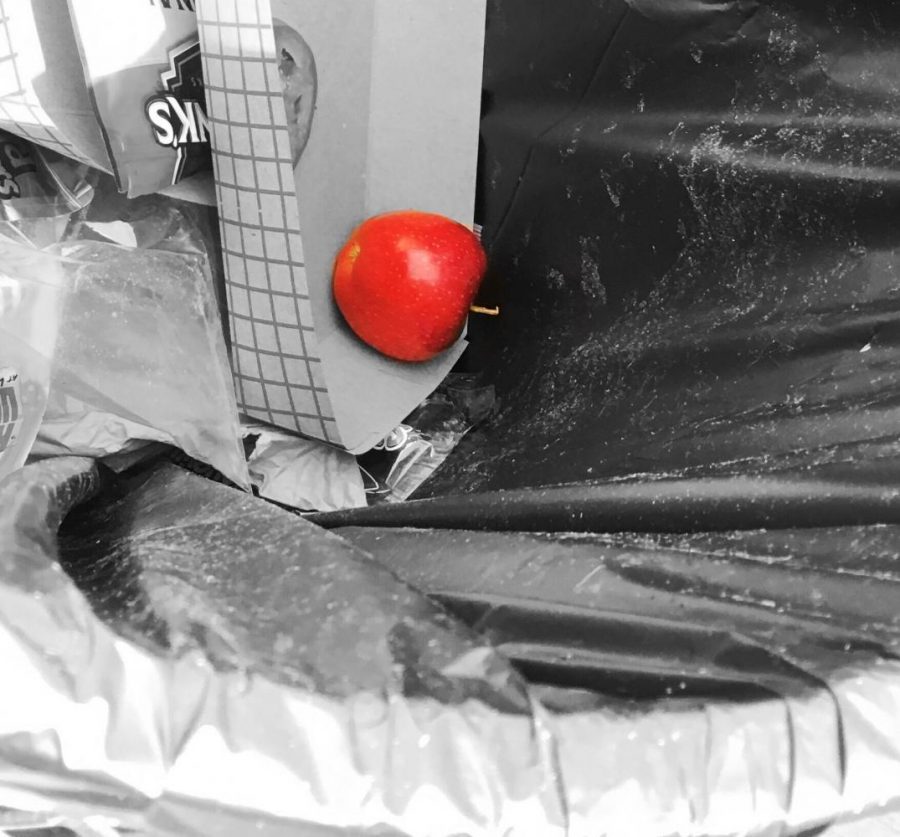Are Schools Feeding The Trash Cans?
The Forceful Inclusion of Fruits and Vegetables in Student Meals
Most fruits are not consumed by students, but instead just thrown away.
October 3, 2017
On a daily basis, when students purchase lunch or breakfast they are mandated to include the fruits and vegetables as a part of their meals; however, does this forceful inclusion really equate to consumption? Or does it merely contribute to the massive amount of food waste perpetuated in our nation? I believe that a health-conscious diet can only be voluntary; it is not something administrative action or even governmental policies can coerce.
It is indisputable that a healthy diet can significantly bolster academic performance; my aim throughout this article is not to argue against a health-conscious diet, but rather the mechanism in which the healthy diet is enforced. Adequate nutrition has been known to contribute to more academic achievement overall, better behavior, and improvement of student cognitive abilities. These claims have been supported by research across institutions including the Federal Center for Disease Control. So what then must be done to ensure that students are receiving these benefits?
For almost a decade, the solution under the Healthy, Hunger Free Kids Act has been to force the inclusion of fruits and vegetables in students’ meals. An analysis of the potential solvency of such a solution would reveal that it would, at best, make a microscopic impact on student life. First, in a best-case scenario where the student is assumed to have consumed the fruit or vegetable they were forced to acquire, the school is dictating a student’s diet on two meals across five weekdays. That equates to 10 meals out of 21 meals a week. The impact is not even equivalent to half of the students’ weekly diet. However, this fictitious equation is overly optimistic. Only a portion of the students buy lunch, only a portion of the students buy both breakfast and lunch, and only a portion of these students buy breakfast and lunch daily. And worst of all, the health benefits absorbed at school are easily made ineffectual by the favorable and destructive food at home. The idea I am illustrating is that, even in the most optimal scenario, the school is only making a feeble attempt, and in reality, the school is making just a minuscule impact on a minuscule portion of students.
On top of the fact that the school is influencing the dietary habits of a minority of students on a trivial level, the forceful inclusion of fruits and vegetables in students’ meals does not necessarily constitute consumption. Somedays I attempt to purchase lunch without including a fruit or vegetable in my meal because I know, definitively, the fruit or vegetable will not be part of my lunch; of course, I would be ordered to pick up a fruit or vegetable anyways. It merely is an object I was told to pick up, so immediately out the cafeteria I would toss the fruit or vegetable into the trash can.
Junior Tony Cheng, who similarly relies on school lunches, would always “throw away the fruit as soon as [he] sees a trash can. [Tony] always feel[s] guilty, but it was not [him] that chose to grab the fruit.”
It is logically fallacious to assume that students would candidly consume their fruits and vegetables just because they had picked it up at the line. Fruits and vegetables are simply not appealing enough to cater to the captious taste buds of teenagers. According to CBS, after schools started to mandate the inclusion of fruits and vegetables in student meals, food waste amongst schools increased by 56%, indicating that students are simply tossing out whatever undesired food the school forces upon them.
One could contend that even with all this ineffectuality, at least some students can benefit. Some students must be consuming the fruits that are forced upon them. Someone must be the beneficiary of this inept system. These claims, I wholeheartedly agree with. Even with its lack of solvency, some nutritional prosperity must have been derived from this mandate. However, as with any governmental policy, we must examine the risks versus the rewards. The students that do buy lunches are not responding as policy would expect. We are wasting money, but more importantly, we are wasting food. This mandate only contributes to the alarming food waste issue witnessed in our nation. According to BBC, 40% of all food produced in America is wasted. A large portion of that waste, as reported by LA Times, occurs in schools. Across the nation, students account for 10% of the nation’s squandering. In our second largest district in America, 100,000 dollars worth of food is tossed out each day. The net worth is plainly not sufficient justification for the systematic misuse of food and staggering financial expenditures.
So we have established that the status quo lacks solvency, but what better solutions are worth exploring? It is worth noting that I am not against the Healthy, Hunger Free Kids Act. I believe that nutrition is most quintessential in a student’s academic pursuit. As a student of educational ambition, the healthy substances provided at the lunch lines are appreciated, but the mandatory nature in which the fruits and vegetables are imposed is not. Instead of focusing on students having the fruits or vegetables as part of their meals, the government should focus on the fundamental, dietary habits of students. Focus on health education to induce change beyond the duration in which students stay at school and provide education that teaches the students that they have to consume the fruits and vegetables themselves willingly. Meanwhile, the school can continue to sell gluten free, low fat, low sodium, and in general health-conscious foods; however, fruits and vegetables would become an option, not a mandate. The administration should offer it so that students may consume it when they desire or deem it necessary.
In having the students voluntarily include the fruits and vegetables as a part of their meal we can foster a sense of responsibility for their consumption behavior. Furthermore, a large amount of funds would be free from being squandered on fruits ultimately bound for the trash cans. Imagine the potential achievements in place for schools if that funding is allocated to a more appropriate area. This solution would bypass the large amounts of financial and food waste plaguing our nation and uphold the nutritional standards rightfully expected in an academic environment.







































Jacob Belford • Oct 12, 2017 at 3:06 PM
Very informative article that poses great points about a lesser known issue. It is written well and demonstrates how schools are trying palpable methods to ensure their students obtain a healthy diet. I am impressed by the author and hope that the individual continues to keep up the great work.